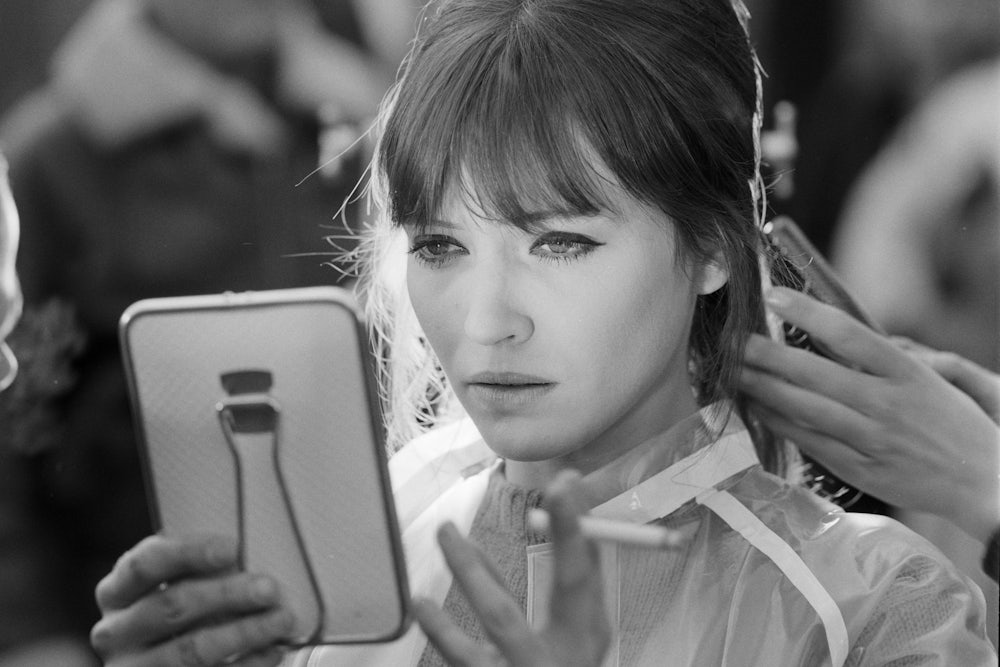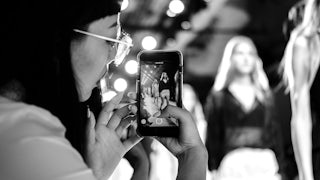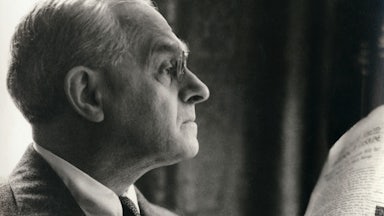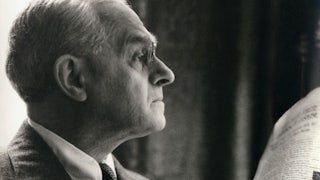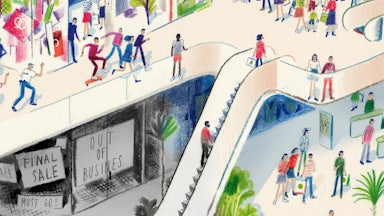“If, approaching the end of the world, we’re forced to choose a single surviving monument to human art,” the author and critic Joanna Walsh writes in the opening lines of My Life as a Godard Movie, “it won’t be how any particular work of art looks, but the act of looking.” In this single-essay publication, and in a new volume of critical theory titled Girl Online: A User Manual, Walsh concerns herself with the reality of occupying a female body in a screen-dominated age when even civilians are obliged to be looked at as if they are actresses or models—when projecting a perfected image of oneself for an audience of total strangers is no longer the preserve of, say, Anna Karina in the films of Jean-Luc Godard but a necessary requirement for any woman who desires to be seen to exist on the web. The internet, Walsh suggests in Girl Online, is not for women at all but for girls, who are defined by their desirability, their malleability, and their cheerful object status.
“Who has more power to manifest via the pure appearance that is screen mode,” she asks, than a white, slim, conventionally hot girl, who online becomes “an avatar for everyone?” Watching Anna Karina look at her own perfect face reflected in a mirror in Une Femme Est Une Femme, Walsh poses three questions—“What is she checking? That she is beautiful? That she is there?”—that might just as easily apply to any of the gorgeous, contoured strangers who appear in the Explore feed of my Instagram account, projecting themselves into their front-facing cameras.
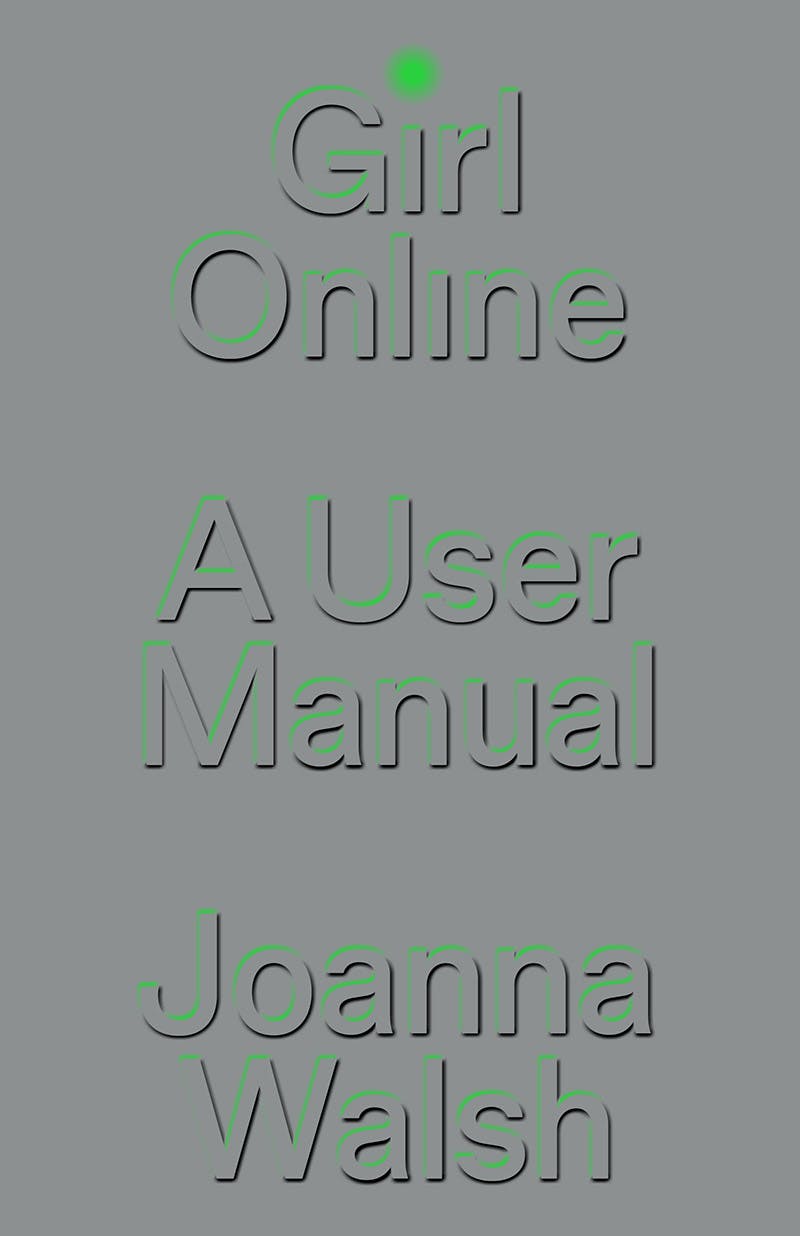
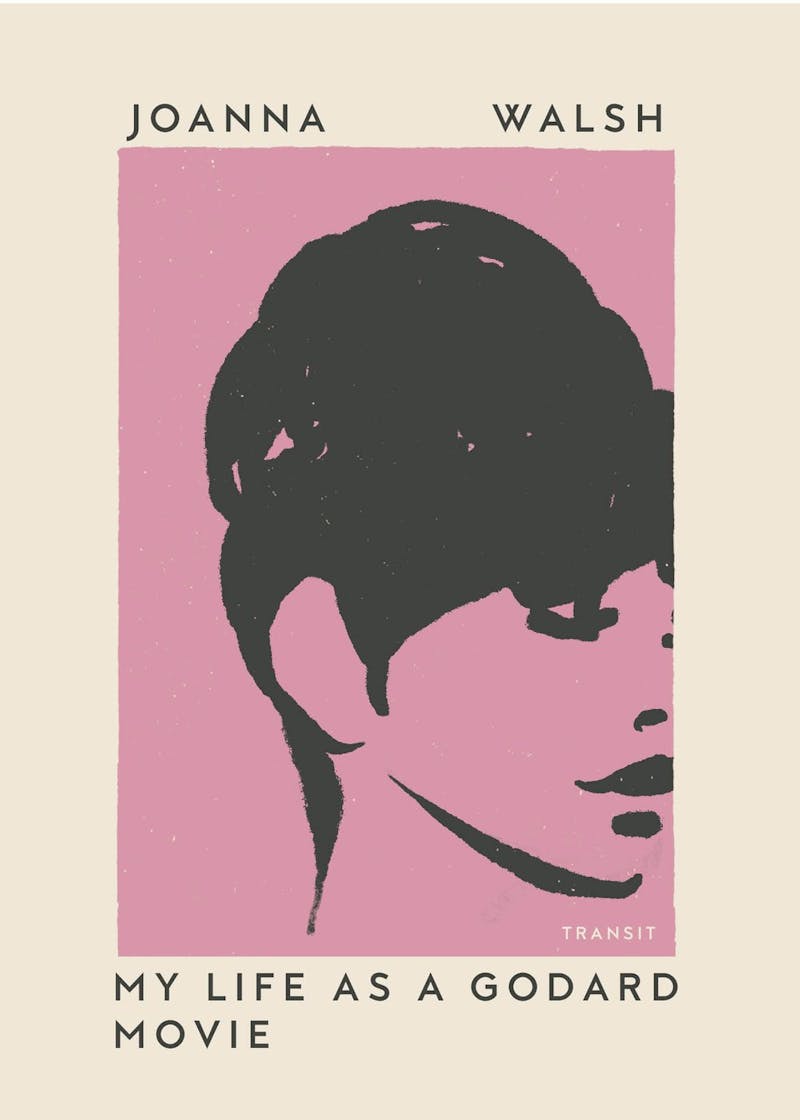
Both books touch on a phenomenon that has irked me personally for some years but which I rarely see addressed directly: namely, the idea that women who write professionally are now seemingly expected to present themselves like influencers, to fit into high-end clothes in order to be photographed for interviews, and so on. If the expectation is not technically a universal one, it is certainly pervasive, and if one does not strictly have to comply, it is professionally advantageous to do so. (Only one earlier example of this being discussed in literature immediately springs to mind: Kate Zambreno, in 2019’s Screen Tests, grumbling that she never knew until she moved to New York “that women writers were expected to be photogenic.”) Whichever kind of a screen a woman finds herself on, Walsh suggests, it behoves her to be easy on the eye, and this impetus generates a competition that is detrimental to all those who take part in it, as well as some who do not. “In a world where being the most beautiful is the job of all women, having, like any job, different ranks and remunerations,” she writes in My Life as a Godard Movie, “the woman industry relies on one woman being more beautiful than the rest.”
One novel quality of the internet is its ability to reveal the common or universal nature of feelings and experiences we have previously believed to be entirely personal and idiosyncratic, so that when we Google thoughts or questions, we are often surprised to find our own specific wording mirrored back by the results. Arguably, the best theory and personal essay-writing does the same: Walsh, who has also spoken out against the tendency of many literary prizes to define an “up-and-coming writer” solely as a writer under 35, writes fearlessly about aging as a woman in general, and in My Life as a Godard Movie in particular she articulates the sickening feeling of only ever appreciating one’s body in the rearview mirror with such terrible precision that it stunned me. “Beautified,” she admits, “I now look not like an achievement, but [like an] attempt.… I had waited so long for my moment to become beautiful. I watched out for it carefully, but if it came, I did not see it.”
In My Life as a Godard Movie, Walsh rewatches Godard’s 1960s output during lockdown, ordering the titles in accordance with the dominant color in their cinematography—so that La Chinoise represents red, Weekend represents yellow, and so on. She finds that she shares a minor eccentricity with the director: a deep-seated dislike of the color green. (“There have been essays about falling in love with a color,” she says wryly, a brief nod to Maggie Nelson’s Bluets. “How about falling in hate?”) “Green,” of course, can also be taken to mean inexperienced or naïve, and an envious person can be said to look upon the subject of their envy with green eyes; seeing Godard’s heroines on-screen, modish and free-spirited and fashionable and young, Walsh confesses to experiencing numerous emotions at the same time, from desire to identification to, yes, envy. “Perhaps one day it will end,” she muses, “this practice of putting women on show … that began with the twentieth century, that began with film. In the meantime, look at the beautiful woman. I am ‘like’ her, yet utterly unlike her. The magic of cinema!”
The illusion that we are “like” the actresses we admire in the movies is a complex one, since part of their job description is ensuring that they are perpetually glossier than, prettier than, and thinner than the women paying to see their films, making any attempt to catch up with them a losing game. Walsh recalls trying to dress like a Godard girl in her teens, making a New York Herald Tribune T-shirt as an homage to the one worn by Jean Seberg in his 1960 film À Bout de Souffle. “The green gaze of envy is solved by identification: if I can’t be as beautiful as Seberg, perhaps I can dress like her,” she writes. “I have studied Godard’s movies by trying to live them, and I have tried to live them by dressing for them.” In this sense, she recognizes, telegenic on-screen ingénues have a direct relationship with yet another kind of green—that of money. They are product and advertisement in one, selling a concept and being sold as an object simultaneously. The more an actress displays her beauty, Walsh suggests, “the more its value increases: value that she or [a director] can vend.”
If the way a new-wave starlet makes her money is by allowing herself to be immortalized on-screen, gazed at in perpetuity, what about the rest of us? In Girl Online, Walsh dissects a more quotidian experience of being an on-screen woman: that of being female and online, relying on the internet for work and for professional advancement, trying to figure out what kind of image to project for maximal success. “Remember that when a screen is on, we say that it is ‘working,’” she writes. “When a screen’s off, can it (can I?) be said to be working? Am I sleeping? Am I dreaming, like Alice?” Throughout the book, she makes frequent reference to Alice in Wonderland, whose through-the-looking-glass forgetting of her own identity and dreamy, girlish self-abstraction make her analogous to a social media user carving out a new character for herself.
Like a great number of women, Walsh is juggling several roles in perpetuity—motherhood, a career as a writer, the act of doing domestic work—and so figuring out what exactly to embody day to day, moment by moment, is a chore. “I know who I was when I got up this morning,” as Alice tells the caterpillar in Alice in Wonderland, “but I think I must have been changed several times since then.”
Walsh sees another version of the online girl tumbling down the rabbit-hole in Carrie Bradshaw, the columnist and girl-about-town from HBO’s Sex and the City, often pictured sitting in front of her screen and wondering how to be. Carrie is a woman in age, but she is a girl in temperament and build, fun and flighty and sylphlike and perpetually in fashion; she is internet-illiterate in the original series, which went off-air about a year after the invention of MySpace, but her flirty and eccentric manner of dressing has endured on Instagram in 2022, finding favor with Gen Z. As a narrative device in every episode of the show, Carrie asks a question: “Is there a secret cold war between singles and marrieds?” for instance, or “Are threesomes the new sexual frontier?” She not only poses these inquiries, Walsh suggests, “but, embodying each dilemma, is ‘in question’ … perhaps the performance of the question is the point.” A frequent criticism of Carrie’s character is her unsuitedness to being a sexual guru, given how unknowledgeable she appears to be about sexual life outside the most conventional heterosexual coupling. Still, this innocence—this greenness—only adds to her girl status. Being an open-ended query is an ideal state for an online girl, who will doubtless find a million other users hoping to provide her answer, helping to unknot her prettily furrowed brow.
“White, able-bodied, not quite old enough for the screen to entirely refuse my face,” Walsh admits in Girl Online, “I superficially resemble the images of girls that slipped from big screen to small, to digital, their functions carried over as the face of a brand, a generation, a revolution.” Offline, though, it is significantly harder to maintain the state of girlhood than it is when we are designing whichever version of ourselves exists on the web, and “to move across time from girl to woman,” she concludes, “is to land in the place where payment is taken.” (Even Carrie Bradshaw—who in the most recent incarnation of her show, And Just Like That, is 55 and requires hip surgery—is now expected to maintain an Instagram account and to co-host a streaming podcast in order to maintain her career as a girl-about-town writer, and part of that series’s curiously depressing air sprang from the impossible tension of trying to uphold her carefree and questioning nature in the face of grief and aging.)
In her off-screen life, separate from the literary self those who encounter her online may be more familiar with, Walsh writes that she is employed as a cleaner and domestic laborer, having decided that the separation of her income and her art will help her maintain a degree of purity in her work—“the only art that means anything,” she says, “is given away for free.” Through Girl Online, which she describes as an “anti-manifesto” whose ideal reader is the internet itself, she comes to see the fracturing of identity that both womanhood and the web require as a double-edged sword, capable of being used to hold back something from the market and the male gaze, both.
Above all else, Girl Online and My Life as a Godard Movie ably, bravely explore yet another kind of split: that between theory and practice when it comes to female self-empowerment. It is possible to know that youth and beauty are not all that meaningful in comparison with, say, intellect or professional success and yet to desire youth and beauty feverishly at the same time, especially when one sees just how many advantages these qualities can confer. In Une Femme Est Une Femme, when Anna Karina’s adorable striptease artist, Angela, clocks into her shift, the signs in the club offer a “spectacle permanent”—a continuous floor-show, the dancers stripping and parading in a loop for the handful of drunk men who pay to see them. As Angela does her routine, Godard moves his focus to Karina’s face to spare her nakedness, but the sequence is still playfully sensual, crackling with the electricity of her charisma. It is easy to see why this moment in particular is iconic: the 19-year-old Karina winking straight out of the screen at the spectator, never changing, never aging, always fun and free. Being smart or powerful or interesting is great, and we all have to grow up into women some time; but wouldn’t it also be nice to be permanently spectacular like this?
